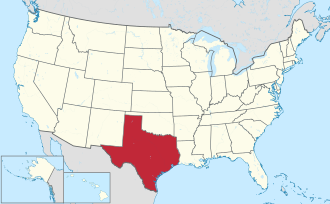Culberson County | |
|---|---|
 Culberson County Courthouse in Van Horn | |
 Location within the U.S. state of Texas | |
 Texas's location within the U.S. | |
| Coordinates: 31°27′N104°31′W / 31.45°N 104.52°W | |
| Country | |
| State | |
| Founded | 1912 |
| Named after | David B. Culberson |
| Seat | Van Horn |
| Largest town | Van Horn |
| Area | |
• Total | 3,813 sq mi (9,880 km2) |
| • Land | 3,813 sq mi (9,880 km2) |
| • Water | 0.2 sq mi (0.5 km2) 0.01% |
| Population (2020) | |
• Total | 2,188 |
• Estimate (2024) | 2,254 |
| • Density | 0.6/sq mi (0.2/km2) |
| Time zones | |
| most of county | UTC−6 (Central) |
| • Summer (DST) | UTC−5 (CDT) |
| northwestern | UTC−7 (Mountain) |
| • Summer (DST) | UTC−6 (MDT) |
| Congressional district | 23rd |
| Website | www |
Culberson County is a county located in the U.S. state of Texas. As of the 2020 census, its population was 2,188. [1] The county seat is Van Horn. [2] Culberson County was founded in 1911 and organized the next year. [3] It is named for David B. Culberson, a Confederate soldier and U.S. representative.
Contents
- History
- Native Americans
- Explorations
- County established and growth
- Space exploration
- Geography
- Major highways
- Adjacent counties
- National protected areas
- Demographics
- 2020 census
- Communities
- Town
- Unincorporated communities
- Ghost towns
- Education
- Politics
- See also
- References
- External links
Culberson County is primarily in the Central Time Zone, but northwestern Culberson County, including Guadalupe Mountains National Park, is in the Mountain Time Zone, making it one of only a few U.S. counties officially split into two time zones. It is one of the nine counties that comprise the Trans-Pecos region of West Texas.




